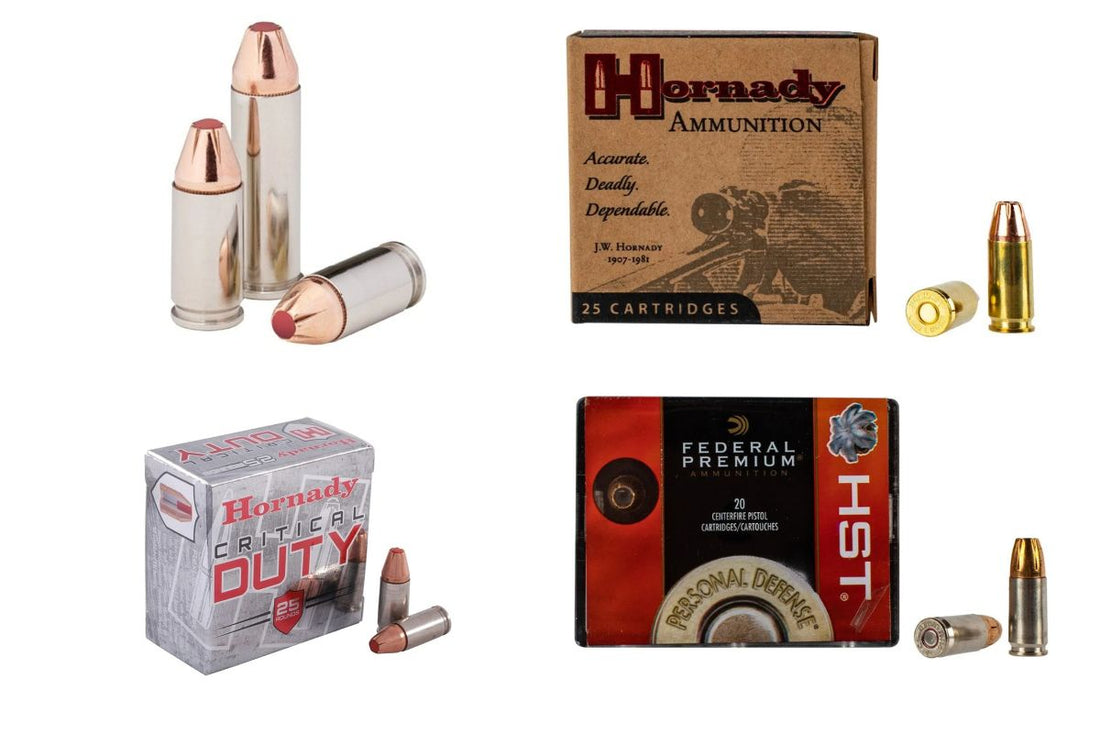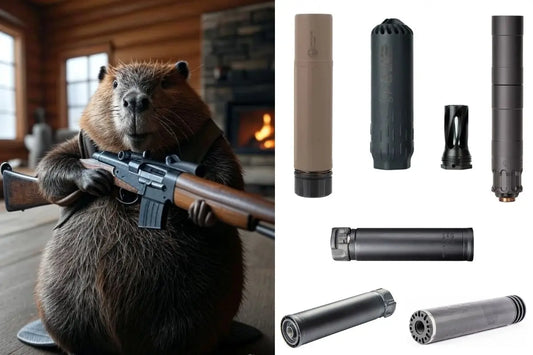
Hollow Points vs. Polymer-Tipped Expanding Bullets for Defensive Use: A Candid, Data-Driven Comparison
TL;DR for Skimmers
If your priority is the most consistent expansion across real-world obstacles like heavy clothing, modern polymer-tipped expanding bullets usually have the edge. Traditional hollow points remain a proven, effective choice—especially if they are reliable and accurate in your particular firearm—but they are more likely to under-expand when the cavity clogs. For either type, performance is platform- and load-specific; what matters most is reliable function and demonstrated terminal behavior in your handgun.
Quick Summary Table
|
Feature |
Traditional Hollow Point (HP) |
Polymer-Tipped Expanding (PTX) |
|
Expansion mechanism |
Open cavity mushrooms in soft tissue |
Plastic insert initiates expansion and resists clogging |
|
Barrier performance (clothing, light intermediate barriers) |
Can clog and under-expand |
More consistent expansion across barriers |
|
Feeding reliability in semi-autos |
Good in quality designs; some guns prefer certain profiles |
Often smoother feeding due to ogive/tip geometry |
|
Accuracy potential |
Typically, “service grade,” plenty accurate at defensive distances |
Often slightly better BC; practical advantage is modest at short range |
|
Recoil & POI shift |
Load-dependent; similar to PTX |
Load-dependent; similar to HP |
|
Cost & availability |
Usually less expensive, widely available |
Typically, pricier and sometimes less available |
|
Legal classification in restrictive jurisdictions |
Usually clearly defined as HP |
In a few areas, polymer tip can be treated differently—check local law |
|
Over-penetration risk vs. FMJ |
Reduced vs. FMJ; risk rises if cavity clogs |
Reduced vs. FMJ; more consistent through clothing |
|
Best fit (general rule) |
Budget-conscious, proven performance in your specific firearm |
Maximum consistency through common barriers, modern design benefits |
How Each Bullet Works (and Why It Matters)
Traditional Hollow Points (HP). A hollow point has an open cavity at the nose. On impact with soft tissue, hydraulic pressure causes the cavity to peel back the jacket and/or upset the core, increasing diameter (expansion). Expanded diameter increases drag, which helps keep penetration within a preferred window and transfers energy more efficiently than non-expanding bullets. The design risk is that fibers—like those from denim or heavy coats—can pack the cavity before the bullet enters soft tissue, reducing or delaying expansion.
Polymer-Tipped Expanding (PTX). Think of PTX as a hollow point whose cavity is pre-filled with a polymer plug. That insert serves two roles:
- Prevents clogging by keeping the cavity clear until impact.
- Acts as a wedge/ram that drives into the cavity on impact, helping initiate and regulate expansion.
PTX designs also often benefit from a sleeker ogive, which can improve feeding in some semi-autos and (marginally) improve aerodynamics—more relevant for longer-range shooting than typical defensive distances.
Terminal Performance: The FBI Yardstick
A widely referenced benchmark for service handgun ammunition is the FBI 10% calibrated ballistic gelatin standard, which looks for 12–18 inches of penetration in gel, with and without common barriers (e.g., heavy clothing). This is not an endorsement of any specific brand; it’s a performance envelope designed to balance adequate penetration with reduced over-penetration risk in complex, real-world conditions.
- HP Reality Check: Many traditional HP loads do very well in bare gel but can under-expand in heavy clothing, sometimes over-penetrating as a result.
- PTX Advantage: Polymer-tipped designs were largely created to stabilize expansion through barriers, so they tend to hit the 12–18″ window more reliably across test conditions—though not universally, because bullet weight, velocity, and construction matter a lot.
Bottom line: If you prioritize cross-condition consistency, PTX has a structural advantage. If you can confirm that a given HP load stays in the FBI window in your own platform, HP remains a solid choice.
Reliability & Function in Your Firearm
Ammunition is part of a system that includes your specific handgun’s feed ramp geometry, magazine design, recoil spring rate, and chamber dimensions. Two considerations dominate:
- Feeding/Chambering:
- HP: The open cavity and sometimes blunter nose can be finicky in a few guns. Quality modern HP profiles mitigate this.
- PTX: The pointed tip can glide along the feed ramp and center in the chamber more smoothly. This is not universal, but it’s a common observation.
- Ignition & Cycling:
- Both types are offered across bullet weights and pressures (standard vs. +P). Cycling reliability depends on how that load interacts with your gun’s recoil system.
- Expect point-of-impact (POI) shifts between different loads/bullet weights even at short defensive distances. Zeroing and verification matter.
Practical takeaway: Whatever you choose, verify faultless function in your firearm—feeding from full magazines, slide-lock reloads, and with a firm and imperfect grip. Consistency beats theory.
Barrier Performance in the Real World
Real defensive shootings are rarely “bare gel.” Clothing, light intermediate barriers, and angled impacts can change the pressure dynamics at the nose.
- HP: Vulnerable to cavity clogging from fibers, which can prevent the mushrooming effect and increase penetration beyond the intended window.
- PTX: The plug helps shed or compress material without clogging, keeping the expansion mechanism working as intended. Through heavy clothing, PTX designs typically retain expansion more often.
Caveat: Neither design is magic. Glass, steel, and other hard barriers can deform handgun bullets unpredictably, sometimes reducing expansion or skewing their path. That’s one reason the 12–18″ penetration guideline includes barrier tests, not only bare gel.
Accuracy & Recoil
At defensive distances (say, 0–25 yards), the ballistic coefficient advantage of PTX is not a game-changer. The dominant accuracy variables are:
- Your grip, sight alignment, and trigger press.
- Your gun’s barrel, crown, and lock-up.
- Lot-to-lot consistency of the ammunition.
PTX sometimes shows excellent lot uniformity and a more stable meplat, which can translate to tight groups in some pistols. But an accurate HP in your gun will beat a theoretically superior PTX that your gun doesn’t love.
Recoil: Comparable when bullet weight and velocity are similar. Some PTX offerings use specific propellants to hit velocity targets; felt recoil differences are minor and platform-dependent.
Cost, Availability, and Practical Ownership
- HP tends to be more affordable and widely available across more bullet weights.
- PTX is often premium-priced. If budget limits the quantity you can test and keep, the “premium” advantage erodes quickly.
Inventory strategy (high-level):
- Keep enough of your selected load to verify function in your gun, maintain carry rotation, and replace any rounds that have been repeatedly chambered (bullet setback risk rises with repeated chambering).
- Track lot numbers. If you have to switch lots, re-verify zero and function.
Legal and Policy Considerations
Important: Legal frameworks vary widely. While both HP and PTX are designed to reduce over-penetration relative to FMJ, some jurisdictions regulate bullet types differently, and policy (for duty or security roles) may mandate specific categories or test results. The safest course is to study local statutes and, if applicable, your agency/employer policy before purchasing or carrying any specific ammunition.
Pros & Cons (Critical View)
Traditional Hollow Points (HP)
Pros
- Proven concept with decades of data and field use.
- Cost-effective; easier to buy enough for meaningful function testing.
- Wide variety of bullet weights/pressures for tuning to specific pistols.
- Lower risk of ricochet and over-penetration compared with FMJ when expansion occurs as designed.
Cons
- Clothing clogging risk can reduce expansion and increase penetration.
- Nose geometry can be picky in a minority of pistols.
- Performance can be load- and platform-sensitive; not all HPs are equal.
- Marketing names can obscure real test results; you must verify.
Polymer-Tipped Expanding (PTX)
Pros
- More consistent expansion through heavy clothing/light barriers.
- Often excellent feeding thanks to uniform tip geometry.
- Some designs show tight velocity spreads and strong terminal uniformity.
- Potential accuracy edge in some pistols (case-by-case).
Cons
- Higher cost can limit how much you test or stock.
- Availability may be spottier depending on region and demand cycles.
- In a few locales, legal treatment can differ from traditional HP—know your laws.
- “Premium” label can encourage under-testing (“it must be fine”)—never assume.
When Each Makes Sense
- Choose HP if:
- Budget allows you to thoroughly validate function and POI with your gun.
- Your platform shows excellent reliability with a given HP profile.
- You want broader weight options (e.g., to manage recoil or POI) and you’ve seen gel/field data that meet the 12–18″ goal in heavy clothing.
- Choose PTX if:
- You prioritize cross-barrier consistency (heavy clothing common in your environment).
- Your pistol shows smoother feeding with tipped profiles.
- You accept a higher price in exchange for the above advantages and can still test properly.
Honest verdict: In 2025, well-engineered PTX designs generally offer a reliability margin across clothing that many traditional HPs struggle to match. That said, a well-vetted HP load that runs flawlessly in your gun and demonstrates appropriate penetration/expansion in heavy-clothing tests remains entirely defensible.
How to Evaluate Loads—Responsibly (High-Level, Safety-First)
Here’s a framework to evaluate any expanding handgun load with safety and due diligence:
- Confirm Basic Reliability (Range Safety First)
- Use proper eye/ear protection and follow all range rules.
- Test from full magazines, slide-lock reloads, and varied grips to catch marginal cycling.
- Watch for nose-dives, three-point jams, failure to return to battery, and erratic ejection.
- Verify Point of Impact & Consistency
- Shoot slow-fire groups at 7, 15, and 25 yards using your carry sights/optic.
- Compare with your practice load; note any POI shifts and adjust your holds if needed.
- Observe Terminal Behavior (Ethical and Controlled)
- Review independent test data that use properly calibrated 10% gel and heavy clothing standards. Focus on penetration depth, expansion diameter, and retained weight—not just marketing claims.
- Prioritize loads that repeatedly land in the 12–18″ range through heavy clothing.
- Sustainment & Handling
- Avoid repeatedly chambering the same round; inspect for bullet setback and case mouth deformation.
- Store defensive ammo in dry, temperature-stable conditions.
- Legal Fit
- Validate that the load type complies with local law and, if applicable, organizational policy.
This is intentionally high-level and non-procurement guidance for safety and compliance.
Common Myths—Debunked
-
“PTX is just marketing; it doesn’t change anything.”
Not quite. The tip geometry and clog-resistance do make a measurable difference in many heavy-clothing tests. It’s not universal, but the design intent is real. -
“HPs always under-penetrate.”
Also untrue. Many HP loads reach the FBI window in bare gel and some through heavy clothing. The risk is inconsistency with certain fabrics or impact velocities. -
“More expansion = better.”
Only if penetration stays adequate. A huge petal with 8″ of penetration is not desirable. Balance matters. -
“+P is automatically superior.”
Higher pressure can improve expansion at the cost of recoil and muzzle blast, and it may alter reliability in some guns. Superiority depends on your platform.
Our Opinionated Take
If we had to choose one design philosophy for today’s typical concealed-carry contexts (short barrels, varied environments, common clothing barriers), We’d lean polymer-tipped expanding. The clothing robustness is a real advantage, and modern loads tend to be well-tuned for short barrels. However, that edge evaporates if you can’t: (a) test enough to confirm reliability and POI; (b) maintain a reasonable stock; and (c) ensure legal compliance. A vetted traditional HP that you shoot well and your pistol eats 100% is better than a “fancy” load you haven’t validated.
Safety & Responsibility (Non-Obvious but Crucial)
- Storage: Keep defensive ammunition cool, dry, and secure from unauthorized access. Ammunition can degrade with moisture or oil exposure (e.g., from over-lubed guns).
- Maintenance: Inspect carry rounds periodically for dents, corrosion, or setback, and rotate them responsibly.
- Training: Terminal ballistics won’t compensate for poor hits. Allocate resources to training and verification before chasing marginal ballistic gains.
- Legal reality: After any defensive use, the legal aftermath will scrutinize everything. Knowledge of your local legal landscape, your policy (if applicable), and your training records matters more than the specific brand name on a box.
Recap
- Traditional hollow points (HP): open cavity, proven concept, cost-effective, but more prone to clogging and inconsistent expansion through heavy clothing; reliability depends on your pistol.
- Polymer-tipped expanding (PTX): HP concept with a polymer insert that protects the cavity and initiates expansion more consistently; often feeds smoothly; tends to offer more uniform cross-barrier performance; generally costlier.
- Decision rule: Choose the load type that runs 100% in your handgun, hits to your sights, and demonstrably lands in the 12–18″ FBI gel window through heavy clothing. For many modern short-barrel pistols, PTX provides a consistency edge—but a vetted HP that performs in your platform is absolutely valid.
Visit Brownells.com to shop a wide variety of HP and PTX ammunition.




